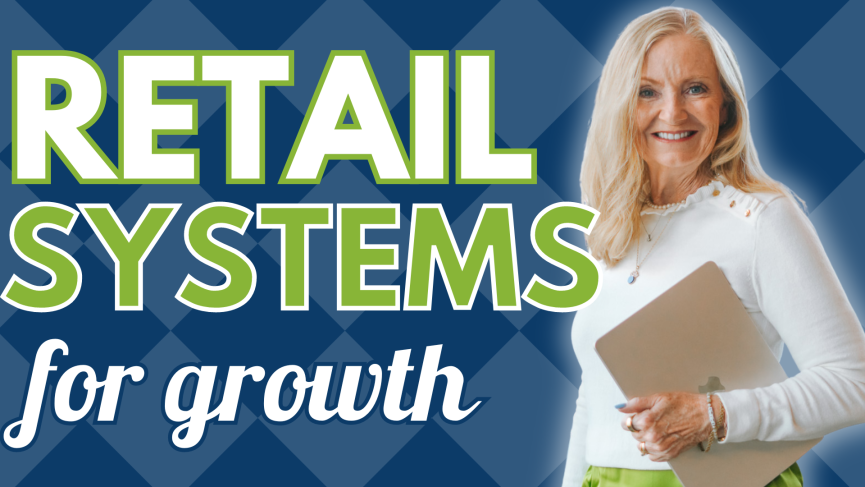What is the #1 indicator of consistent growth? Retail systems! You can not build on a shaky foundation and you can’t grow your retail store without systems and processes that will support that growth. This question came in through our retail community recently:
“I now have one year under my belt, but I’m flying by the seat of my pants! I need a system for everything. Where should I start?”
Yes, you do, Janet! This is a common realization for many store owners. It’s why I created my Sales Breakthrough System — because I learned the hard way that flying by the seat of my pants only led to stress and burnout not more sales.
In the Sales Breakthrough System, I break down the exact steps you should take to grow your sales consistently and sustainably in four distinct areas of your store: finances, inventory, team, and marketing. Let’s dive into how to build effective retail systems in these areas.
Retail Systems: Building Profit, Margin, and Cash Flow
The foundation of a successful retail business lies in solid financial systems. The three most important systems to create and implement in your finances are building profit, building margin, and building cash flow. Here’s a closer look at each:
- Building Profit:
- Pricing Your Products: Ensure your products are priced to cover costs and generate profit. Regularly review and adjust prices based on market trends and cost changes.
- Expense Management: Balance your expenses with your sales. Monitor and control costs to maintain profitability.
- Building Margin:
- Improve Your Markup: Aim for an average Initial Markup (IMU) of 55-60%. This is a natural effect of increasing your pricing and means continuing to price your products so that your profit margin remains healthy.
- Evaluate Expenses: Regularly assess and reduce unnecessary expenses to maintain a strong margin.
- Building Cash Flow:
- Cash Flow Management: Manage your cash flow to reduce stress during slow periods. This includes planning for seasonality and unexpected expenses.
- Cash Reserves: Build and maintain cash reserves to ensure you can handle financial surprises.
Retail Systems: Organize, Balance, Evaluate Inventory
Effective inventory management is crucial for maximizing sales and minimizing waste. Implement these four systems to manage your inventory effectively:
- Organize Your Inventory:
- Inventory Tracking: Use an inventory management system to track stock levels, sales, and reorder points.
- Stock Organization: Keep your inventory organized to reduce search time and improve efficiency.
- Balance Your Inventory:
- Sales Data Analysis: Analyze sales data to balance your inventory levels. Ensure you have enough stock to meet demand without overstocking.
- Regular Audits: Conduct regular inventory audits to maintain accuracy and identify slow-moving items.
- Evaluate Your Vendors:
- Vendor Performance: Regularly evaluate vendor performance based on sell through rate.
- Negotiation: Negotiate better terms and prices to improve your margins.
- Move Old Inventory:
- Clearance Strategies: Implement clearance strategies to move old inventory. This can include discounts, promotions, or bundling items.
- Seasonal Adjustments: Adjust your inventory based on seasonal trends to keep it fresh and relevant.
Team Systems: Hiring, Training, and Optimizing
A strong team is essential for a thriving retail business. Develop systems to hire, train, and optimize your team effectively:
- Hiring System:
- Job Descriptions: Create clear job descriptions to attract the right candidates.
- Interview Process: Develop a structured interview process to evaluate candidates thoroughly.
- Training System:
- Onboarding Program: Implement an onboarding program to train new hires efficiently.
- Ongoing Training: Provide ongoing training to improve skills and keep the team updated with the latest trends and practices.
- Optimizing System:
- Performance Reviews: Conduct regular performance reviews to assess and improve team performance.
- Team Culture: Foster a healthy team culture that encourages collaboration, motivation, and growth.
Retail Systems: Marketing Strategy and Reactivation
Driving consistent traffic to your store is key to growth. Create marketing systems to attract and retain customers:
- Customer Magnet:
- Identify Your Audience: Clearly define your target audience to tailor your marketing efforts.
- Unique Selling Proposition: Develop a unique selling proposition (USP) that sets your store apart from competitors.
- Marketing Strategy and Process:
- Marketing Plan: Create a comprehensive marketing plan that includes online and offline strategies.
- Content Calendar: Develop a content calendar to schedule and organize your marketing activities.
- Reactivation System:
- Customer Database: Maintain a customer database to keep track of purchase history and preferences.
- Re-engagement Campaigns: Implement re-engagement campaigns to bring back inactive customers.
Start with Financial Systems
I know, this sounds like a lot – and it is – but you don’t need to build them all at once. Focus on one area at a time, approaching these retail systems in this order: start with the financial systems, then move on to inventory systems, team systems, and finally marketing systems. This sequence ensures you maximize your efforts and the dollars you keep in your store.
If you feel lost on how to create these systems, or if you want to build them faster and more efficiently, join us inside RETAILMavens Coaching. You’ll have access to the Sales Breakthrough System that walks you through exactly what to do in each area. Get started today for just $99. You have access for a full 12 months, including monthly coaching calls to break through any questions that stop your progress.
Join now and take control of your retail business with effective retail systems!


